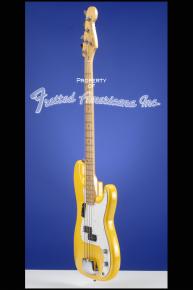A Very Rare Custom Color P-Bass
This lightweight bass weighs just 9.00 lbs. and has a nut width of just under 1 11/16 inches and a full bass scale length of 34 inches. Solid alder body, contoured on back and lower bass bout, one-piece maple neck, and maple fretboard with 20 frets and black dot position markers. Headstock decal with "Fender®" logo in black with gold trim, with "SERIAL NUMBER S885744" in black below it and "PRECISION BASS®" in black beside it, and with "MADE IN U.S.A." in black beneath "PRECISION." Single circular string tree. Individual Fender bass tuners (German-made Schaller tuners with "Fender" on plate) with cloverleaf-shaped metal buttons. Four-bolt neck plate with large Fender backward "F" logo in the center. One split black eight-polepiece pickup with a great, fat pickup output of 10.86k. Three-layer (white/black/white) plastic pickguard. Thumbrest on the bass side of the pickguard. Two controls (one volume, one tone) and jack socket, all on pickguard. Chrome knobs with flat tops and knurled sides. Four-saddle bridge/tailpiece. The neck is stamped: "01029906 [+inverted "S"] J. Flores + FRR 43 + FRR 37 + A." The pots are dated: "137 80 43." There is a sticker with the matching serial number inside the neck pocket. A few very tiny surface marks on the body, otherwise this guitar is near mint. Housed in the original Fender tan hardshell case with yellow plush lining (9.00).
The Precision Bass, with its revolutionary new shape, was launched in 1951 and originally had a slab body. It was not until 1954, with the introduction of the Stratocaster, that Fender contoured the body. All early Precision Basses had one-piece maple necks and it was in 1959 that a slab-board rosewood fretboard was introduced. Many players missed the comfort of the maple fretboard, so from around 1967 to 1969, a one-piece maple neck was offered as an option.
Until the Precision, the bass was an upright acoustic instrument that was difficult to hear and cumbersome to transport. Leo Fender's invention allowed musicians to hold their instrument like a guitar, opening the bass world to curious guitar players, and allowing bass players a level of freedom they had not yet encountered. Due to the bass's solid body construction, it could be amplified to any level, giving it new found aural presence. In its first fifteen years of development, the Precision Bass changed as much as the music it influenced and the musicians it inspired, having been played by everyone from The Shadows to Led Zeppelin.
Monaco Yellow was one of the special custom International Colors (colors named after exotic locations around the world) introduced at the end 1980. "[In 1981] CBS management decided that new blood was needed to help reverse the decline in Fender's image...Briefly available was a new set of Custom Colors known as International Colors, illustrated in the 1981 catalog [and] intended to make existing stock more attractive. However, many of the hues were distinctly lurid...They were not liked at the time" (Tony Bacon, 50 Years of Fender, p. 78).
Translate:









